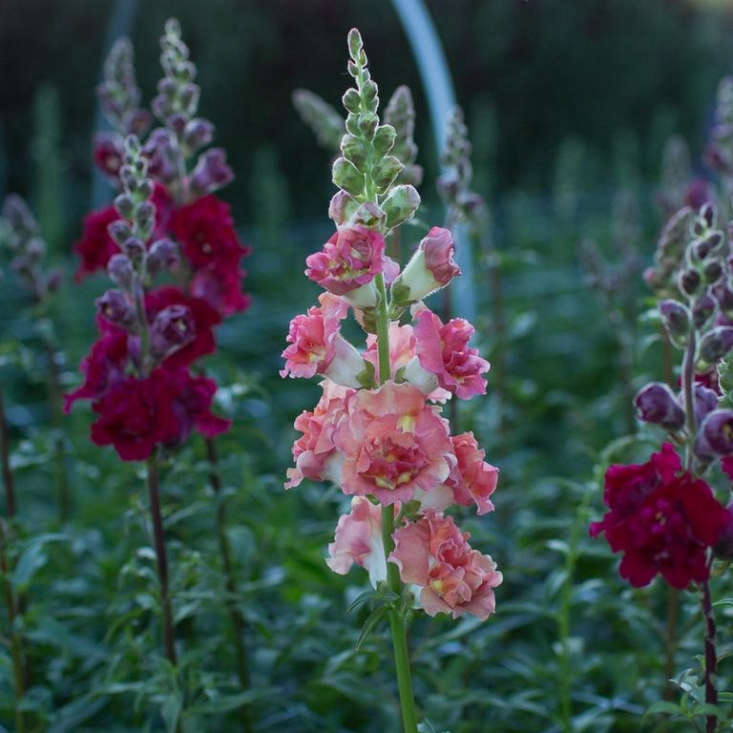Snapdragons, Antirrhinum majus
An old-fashioned cottage garden flower that bears a resemblance to its cousin the foxglove, a snapdragon produces small clusters of flowers on a tall, sturdy stalk. Name almost any color, and there is a snapdragon variety that blooms in that hue: pink, red, white, yellow, orange, purple, bicolor, speckled, have you heard enough?
Although there are more than 25 different species of this wildflower which is native to Europe and Asia, Antirrhinum majus is type the most frequently grown in gardens. They can be fragrant, and may bloom in explosive fireworks colors or soft pastels, or chaste whites. The bell-shaped flowers may be singles, double blossoms, azalea-shaped (with extra petals) or have open faces.
A tender perennial or annual, depending on the climate and growing conditions–actually, let’s call it an annual to avoid getting gardeners’ hopes up unfairly–a snapdragon can grow as tall as 3 feet or be as compact as 8 inches, depending on whether it’s a giant or a dwarf variety. (The medium types fall somewhere in between.)
Which snapdragon are you going to plant this year? And are you going to start it from seed or buy seedlings from the plant nursery? Read on to find out everything you need to know to decide:

Snapdragons have a long bloom season; after the first flowers fade, plants will send up new shoots from their bases. Expect flowering to continue in late summer.
There is a snapdragon for every sunny spot in the garden, from a rock garden to the edge of a flower bed to the foot of the rose bushes, where snapdragons’ foliage and bright colors can divert attention from even the thorniest woody canes.

Snapdragons attract pollinators, especially long-throated bumblebees which can navigate the deep flowers to reach the nectar.

When it comes to choosing a species, flower farmer Erin Benzkein prefers Antirrhinum majus. “No other snapdragon possesses so many desirable traits in one plant: beautiful warm colors, tall strong stems, delicate ruffled blooms, and the loveliest citrus scent,” she says.

Some advice on growing these old time-y favorites, from garden writer Anne Raver: “These graceful old-fashioned spikes of color do best planted early, in cool weather. They will bloom heavily in summer, and again in the fall if you cut them back during the dog days.”

Dwarf snapdragon varieties, many developed in the 1930s for use in rock gardens and to edge flower beds, also are a good choice for container gardens.
Cheat Sheet
- To grow the prettiest kinds of old-fashioned flowers (instead of the loutish, harshly colored strains prevalent at garden centers), start snapdragons from seed. For heirloom varieties, a packet of 1,125 Snapdragon ‘University of California Mix’ seeds will produce flowers in shades of pink, rose, white, and bicolor” and is $3 from Select Seeds.
- When harvesting flowers from a cutting garden, for best results “they need to be cut in the morning before the sun hits them, or after the sun has sunk for the day.” Read more advice at 12 Tips for Growing Cutting Flowers from Barberry Hill Farm.
- For a charming floral arrangement, pair poppies with snapdragons. See step-by-step instructions in Rethinking Poppies: How to Make a Fragile Flower Last Longer.

Keep It Alive
- Plant snapdragons in full sun and well-drained, moist soil. After the root systems get established, give snapdragons 1 inch of water per week.
- Favorite companion plants for Antirrhinum majus include roses.
- If you live in a warm climate (USDA growing zones 8 or 9), you may be able to grow snapdragons as a tender perennial–unless they succumb to mold, frost, wilt, or any of the other plagues to which they are rather susceptible. (Clip any leaves that look as if they might be diseased; they probably are.)
Read more growing tips in Snapdragons: A Field Guide to Planting, Care & Design in our curated guides to Annuals 101 (again, let’s be realistic). See more ideas for cottage garden design:
- Everything You Need to Know About Cottage Gardens
- Foxgloves: A Field Guide to Planting, Care & Design
- Steal This Look: Irish Cottage Garden
- Sweet Peas: A Field Guide to Planting, Care & Design
- Cottage Gardens: Favorite Flowers, with Grace Alexander’s Seeds









Have a Question or Comment About This Post?
Join the conversation